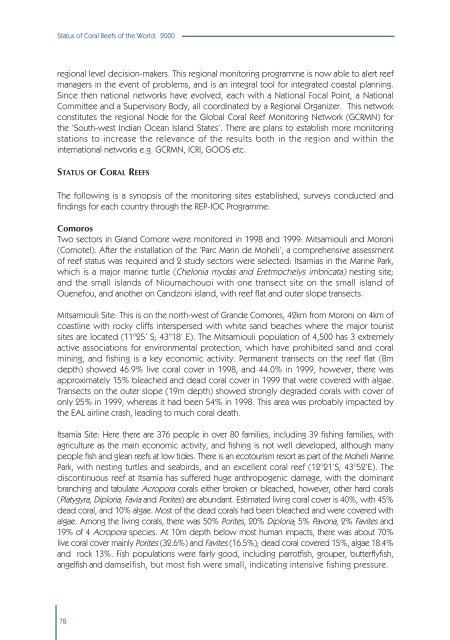Status of Coral Reefs of the World 2000
Status of Coral Reefs of the World 2000.pdf
Status of Coral Reefs of the World 2000.pdf
- No tags were found...
You also want an ePaper? Increase the reach of your titles
YUMPU automatically turns print PDFs into web optimized ePapers that Google loves.
<strong>Status</strong> <strong>of</strong> <strong>Coral</strong> <strong>Reefs</strong> <strong>of</strong> <strong>the</strong> <strong>World</strong>: <strong>2000</strong><br />
regional level decision-makers. This regional monitoring programme is now able to alert reef<br />
managers in <strong>the</strong> event <strong>of</strong> problems, and is an integral tool for integrated coastal planning.<br />
Since <strong>the</strong>n national networks have evolved, each with a National Focal Point, a National<br />
Committee and a Supervisory Body, all coordinated by a Regional Organizer. This network<br />
constitutes <strong>the</strong> regional Node for <strong>the</strong> Global <strong>Coral</strong> Reef Monitoring Network (GCRMN) for<br />
<strong>the</strong> ‘South-west Indian Ocean Island States’. There are plans to establish more monitoring<br />
stations to increase <strong>the</strong> relevance <strong>of</strong> <strong>the</strong> results both in <strong>the</strong> region and within <strong>the</strong><br />
international networks e.g. GCRMN, ICRI, GOOS etc.<br />
STATUS OF CORAL REEFS<br />
The following is a synopsis <strong>of</strong> <strong>the</strong> monitoring sites established, surveys conducted and<br />
findings for each country through <strong>the</strong> REP-IOC Programme:<br />
Comoros<br />
Two sectors in Grand Comore were monitored in 1998 and 1999: Mitsamiouli and Moroni<br />
(Comotel). After <strong>the</strong> installation <strong>of</strong> <strong>the</strong> ‘Parc Marin de Moheli’, a comprehensive assessment<br />
<strong>of</strong> reef status was required and 2 study sectors were selected: Itsamias in <strong>the</strong> Marine Park,<br />
which is a major marine turtle (Chelonia mydas and Eretmochelys imbricata) nesting site;<br />
and <strong>the</strong> small islands <strong>of</strong> Nioumachouoi with one transect site on <strong>the</strong> small island <strong>of</strong><br />
Ouenefou, and ano<strong>the</strong>r on Candzoni island, with reef flat and outer slope transects.<br />
Mitsamiouli Site: This is on <strong>the</strong> north-west <strong>of</strong> Grande Comores, 42km from Moroni on 4km <strong>of</strong><br />
coastline with rocky cliffs interspersed with white sand beaches where <strong>the</strong> major tourist<br />
sites are located (11 o 25’ S; 43 o 18’ E). The Mitsamiouli population <strong>of</strong> 4,500 has 3 extremely<br />
active associations for environmental protection, which have prohibited sand and coral<br />
mining, and fishing is a key economic activity. Permanent transects on <strong>the</strong> reef flat (8m<br />
depth) showed 46.9% live coral cover in 1998, and 44.0% in 1999, however, <strong>the</strong>re was<br />
approximately 15% bleached and dead coral cover in 1999 that were covered with algae.<br />
Transects on <strong>the</strong> outer slope (19m depth) showed strongly degraded corals with cover <strong>of</strong><br />
only 25% in 1999, whereas it had been 54% in 1998. This area was probably impacted by<br />
<strong>the</strong> EAL airline crash, leading to much coral death.<br />
Itsamia Site: Here <strong>the</strong>re are 376 people in over 80 families, including 39 fishing families, with<br />
agriculture as <strong>the</strong> main economic activity, and fishing is not well developed, although many<br />
people fish and glean reefs at low tides. There is an ecotourism resort as part <strong>of</strong> <strong>the</strong> Moheli Marine<br />
Park, with nesting turtles and seabirds, and an excellent coral reef (12 o 21’S; 43 o 52’E). The<br />
discontinuous reef at Itsamia has suffered huge anthropogenic damage, with <strong>the</strong> dominant<br />
branching and tabulate Acropora corals ei<strong>the</strong>r broken or bleached, however, o<strong>the</strong>r hard corals<br />
(Platygyra, Diploria, Favia and Porites) are abundant. Estimated living coral cover is 40%, with 45%<br />
dead coral, and 10% algae. Most <strong>of</strong> <strong>the</strong> dead corals had been bleached and were covered with<br />
algae. Among <strong>the</strong> living corals, <strong>the</strong>re was 50% Porites, 20% Diploria; 5% Pavona, 2% Favites and<br />
19% <strong>of</strong> 4 Acropora species. At 10m depth below most human impacts, <strong>the</strong>re was about 70%<br />
live coral cover mainly Porites (32.6%) and Favites (16.5%); dead coral covered 15%, algae 18.4%<br />
and rock 13%. Fish populations were fairly good, including parrotfish, grouper, butterflyfish,<br />
angelfish and damselfish, but most fish were small, indicating intensive fishing pressure.<br />
78
















